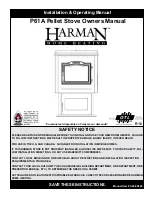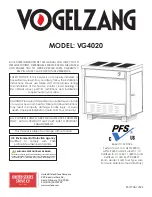
18
It is important to know that for high, combustion efficient, clean
burns, you will need to have sufficient temperatures inside the
firebox for thorough combustion
.
The best method for determining
if you have sufficient temperatures is to watch the brick lining in your
firebox. When you first light your stove or fireplace insert, the firebrick
will turn a dark brown or black. After 20 to 30 minutes of a hot fire, most
of the bricks should return to near their original light brown or yellow
color. This means the firebrick have reached a high enough temperature
for your stove to achieve high combustion efficiency.
Second and just as important, is achieving a high level of heat
transfer efficiency.
Slowing the rate of flow through the stove or insert
enhances heat transfer, thus allowing more time for heat to be transferred
into your home. To do this, be sure to thoroughly preheat your stove and
then reduce the amount of primary air by closing the draft control (lower
left) to about 1/2 to 3/4 open. This will decrease the excess oxygen in
your flue, which carries heat up your chimney, but should still be enough
air to allow the stove to produce its maximum heat output. (More air
may produce a slightly greater amount of heat, but will greatly increase
wood consumption). When the area being heated reaches a comfortable
temperature, slow the burn rate by closing the control to further improve
heat transfer.
To get the most out of your appliance, you will need to combine good
combustion efficiency with good heat transfer practices. The following
are some tips on how to operate your stove to achieve the highest overall
efficiency.
1. Thoroughly preheat your stove before slowing the burn rate by closing
the draft control.
2. Measure the stove temperature at the hottest point on the stove top
or face. Use this information to repeat burn rates.
3. Once preheated, add wood (if needed) and partially close the draft
control (lower left).
4. Operate your stove as much as possible in the low to medium burn
ranges.
5. Do not lower the draft setting so low as to completely extinguish the
flames in the firebox. Check for at least some small flames twenty
minutes after setting the draft control.
6. Do not continually operate your stove or fireplace insert in the high
(wide open) setting. This wastes wood by carrying a great deal of
heat up the chimney and can damage your stove or fireplace insert
and chimney.
7. Go outside and check your chimney. More than a very small amount
of smoke indicates wasted heat, creosote build-up and pollution.
MAXIMIZING YOUR STOVE’S OVERALL EFFICIENCY
Recent developments in wood burning technology have made wood
burning a cleaner and more convenient way to heat your home. Overall
efficiency in a wood burning appliance is a combination of combustion
efficiency and heat transfer efficiency. Whether heating your entire home,
or just a room or two, your understanding of how to best operate your
stove or insert will enhance its overall efficiency and performance. What
this can mean to you is longer, cleaner burns, less wood use and more
heat.
OPERATING TECHNIqUES AND HINTS
GETTING THE MOST OUT OF YOUR STOVE
The following sections will outline techniques you can use to “get the
most out of your stove.” Please read them carefully.
To achieve long burn times, after having thoroughly preheated the
stove or fireplace insert, let the appliance top cool down to 275
to
400 degrees (on Elites, locate thermometer on the face of the insert
just above the door).
Now load the firebox and set the draft control. At
this point, you may need to burn the stove with the draft open for a few
minutes to ignite the wood. All Country Collection™ stoves are EPA tested
for emissions at low burn with the air control completely closed. Whether
or not you should burn your stove with the air control completely closed
will depend on the following factors:
* How you load your wood
* Your chimney type, height and draft
* Your wood type and its moisture content
* The temperature of the stove or fireplace insert
* Which model stove or insert you have
Experiment with different loading configurations to achieve longer
burns
. Try loading the wood from side to side and nesting it in the ashes
to prevent airflow under and around the wood. Fresh wood should be
loaded to the back of the firebox or to the sides. Hot coals or half burned
wood should be brought towards the front of the firebox. The way you
load your wood can seriously affect burn times. If the new load does
not ignite within a few minutes, try crisscrossing the load to allow more
airflow around the fire, or try a slightly hotter stove temperature.
Determining the lowest setting for efficient low burns
. This will require
some experimentation on your part. Try closing the air control all the
way with the stove temperature at 325 to 350 degrees. If the flames are
completely extinguished, open the air control halfway and then slowly
close it until there is only a small amount of flame. It is important to check
the stove about 20 minutes after setting the draft control as it takes this
long for the stove temperature to stabilize. There should still be some
small flames on or above the wood load.
Use 325 degrees as a starting point
. You can try starting temperatures
25 degrees higher or lower to achieve desired burn times, start 25 degrees
lower if the stove burns the wood too quickly or 25 degrees higher if there
are no flames in the firebox for more than a few minutes after loading the
wood. You may or may not need to burn the stove with the air control
open for a few minutes prior to setting the draft for a low burn, this will
depend on the factors mentioned above.
Be sure not to smolder a fire
overnight. Check your chimney for large amounts of smoke as this
indicates very poor combustion.
It is important to realize that stove technology has changed
. Stoves
have changed a great deal in the last few years. This has led to substantial
changes in the methods of operation in new stoves as compared to older
stoves. In old stoves without full brick linings and ceramic insulation,
the rule was “get the stove as hot as possible before setting the draft on
low for overnight burns.” On newer, high technology Country
®
Collection
stoves, this is not necessary. Although it is still important to have the
stove hot enough to burn efficiently, it will require less preheating. Once
you have determined your optimum operating temperatures for various
burn rates, we believe you will find your stove an extremely convenient
way to achieve your heating needs.
Do not reload the stove for long burns when the stainless secondary
tubes or baffles are glowing red, or when the stove is uncomfortably
hot to load
. This indicates the stove is too hot to load for a long burn.
Also, do not load wood for a long burn on a deep bed of hot coals. Try
stirring the coals a few minutes before loading the stove for a low burn
to allow some of the unburned coals time to burn.
ACHIEVING CLEAN, LONG BURNS
Содержание Canyon ST310
Страница 30: ...30 NOTES...















































